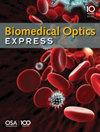利用成像光压计进行公平的非接触式血压估算
IF 2.9
2区 医学
Q2 BIOCHEMICAL RESEARCH METHODS
引用次数: 0
摘要
高血压通常表现为潜伏症状,需要通过专业设备进行检测。这给需要在日常生活中长期接受血压监测的人带来了不便。因此,需要一种便携式、非接触式的血压估测方法。然而,目前的非接触式血压估算方法往往依赖于相对狭窄的数据集,缺乏广泛的血压分布范围。此外,它们的适用性仅限于受控实验环境。本研究提出了一种适用于各种生活场景的非接触式血压估算方法,涵盖多个年龄组、不同种族和不同肤色的个体。目的是提高现有非接触式血压估算方法的实用性和准确性。该研究从面部视频中提取成像血压图(IPGP)信号,并通过四层滤波操作对信号进行处理,以获得反映脉搏波变化的 IPPGP 信号。通过构建 CNN+BiLSTM+GRU 网络结构,提高了现有非接触式血压估算方法的准确性。与现有方法相比,收缩压(SBP)和舒张压(DBP)的平均绝对误差(MAE)分别降低了 13.6% 和 16.4%。本文章由计算机程序翻译,如有差异,请以英文原文为准。
Fair non-contact blood pressure estimation using imaging photoplethysmography
Hypertension is typically manifested as a latent symptom that requires detection through specialized equipment. This poses an inconvenience for individuals who need to undergo long-term blood pressure monitoring in their daily lives. Therefore, there is a need for a portable, non-contact method for estimating blood pressure. However, current non-contact blood pressure estimation methods often rely on relatively narrow datasets, lacking a broad range of blood pressure distributions. Additionally, their applicability is confined to controlled experimental environments. This study proposes a non-contact blood pressure estimation method suitable for various life scenarios, encompassing multiple age groups, diverse ethnicities, and individuals with different skin tones. The aim is to enhance the practicality and accuracy of existing non-contact blood pressure estimation methods. The research extracts the imaging photoplethysmogram (IPPG) signal from facial videos and processes the signal through four layers of filtering operations to obtain an IPPG signal reflecting pulse wave variations. A CNN+BiLSTM+GRU network structure is constructed to improve the accuracy of current non-contact blood pressure estimation methods. In comparison to existing approaches, the mean absolute error (MAE) for systolic blood pressure (SBP) and diastolic blood pressure (DBP) is reduced by 13.6% and 16.4%, respectively.
求助全文
通过发布文献求助,成功后即可免费获取论文全文。
去求助
来源期刊

Biomedical optics express
BIOCHEMICAL RESEARCH METHODS-OPTICS
CiteScore
6.80
自引率
11.80%
发文量
633
审稿时长
1 months
期刊介绍:
The journal''s scope encompasses fundamental research, technology development, biomedical studies and clinical applications. BOEx focuses on the leading edge topics in the field, including:
Tissue optics and spectroscopy
Novel microscopies
Optical coherence tomography
Diffuse and fluorescence tomography
Photoacoustic and multimodal imaging
Molecular imaging and therapies
Nanophotonic biosensing
Optical biophysics/photobiology
Microfluidic optical devices
Vision research.
 求助内容:
求助内容: 应助结果提醒方式:
应助结果提醒方式:


